|
This is a file with graphics and may take a minute to load.
Best viewed full screen. [File Last updated 20/09/2007]
NEW GUINEA RAINBOWFISH

Melanotaenia splendida rubrostriata
QUICK INDEX
|
Salmon-Red Rainbowfish -
Glossolepis incisus (Weber,
1908); Salmon-Red Rainbowfish;
Lake Sentani Red rainbowfish.
Description: large, deep bodied rainbowfish with small head, large eyes and silvery scales;
adult males attain an all-over brilliant salmon-red colouring.
Distribution: Irian Jaya, W. New Guinea:
endemic to Lake Sentani.
Natural Habitat: Lives along
the shores of the lake near submerged vegetation.
Conservation Status: Unknown.
Threats: Habitat degradation
and competition with introduced, exotic, feral species such as carp and
Tilapia. Caught as a
food source in Sentani, Irian Jaya. The lake is also no longer
pristine and the pollution from settlements may endanger this fish.
Size: One of the
larger rainbowfish, growing to 10 cms to 12+ cms.
Water Requirements:
hard freshwater,
tropical, temperature range 25° - 30°C, pH 7.0 - 8.0; dGH range 9.0
- 19.0.
Tank Habitat: needs
space; well planted aquaria with open spaces for swimming.
Diet: Omnivrous. Adapts to flakes and
live foods.
Sexing:
Females silver/golden, slimmer in outline; breeding males salmon-red
and much deeper bodied than females. Females do not have red
colour in any fins or on the body.
Reproduction: Spawns
in plant growth. Do not over-feed.
Tank Community: Ideal for a
community
of larger fish requiring similar conditions, such as other, large rainbows and mbuna that like hard water.
Keep
with
fishes of a similar size (i.e. large when adult).
Incompatible Species:
Unknown. Looks after itself with fish of the same or similar size.
Comments: I have
found this fish to be easily scared into jumping.
Provide cover and a quiet environment. Interestingly, while Max
Weber discovered the fish early in the 20th C., it was not until 1973
that Glossolepis incisus were collected and made their way into
the fish trade. It is a very desirable fish and ought to be
protected and conserved.
|
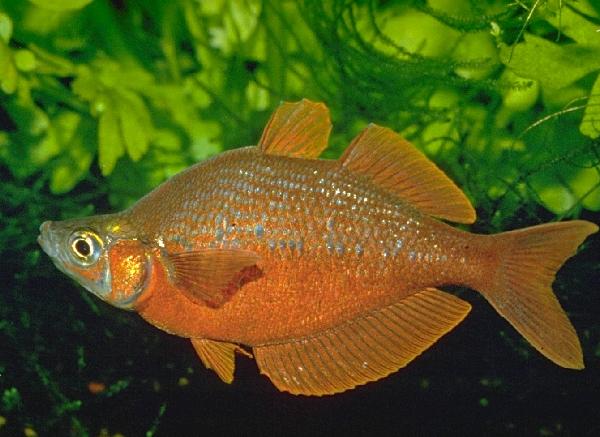
Glossolepis incisus,
male
This fish
requires water that is alkaline and hard. It is an adaptable species, tolerating changes in water conditions, except
for high ammonia/ammonium, nitrite and nitrate levels.
Young fish are all a dull, greenish olive
colour with a trace of silvery sheen. Young
males take time to develop their red colouring and juvenile males look
much like female fish of this species. However, once the
fish
reach a length of 4 to 5 cm the males begin to progressively develop
colour. The change is rapid, with full colour density
reached by the time they are 7 to 8 cms long. Females develop a
yellowish olive body colour with a golden iridescence to the scales. Colour does
not develop well if the water conditions are not correct. Other Glossolepis species are worth a try.
|
|
Boeseman’s Rainbowfish- Melanotaenia boesemani
(Allen & Cross 1980); Lake Ajamaru Rainbowfish.
Description: large rainbowfish, with
a laterally
compressed, deep-set body and a relatively small head; vivid colour in mature males;
iridescent
scales; body appears bi-coloured dark, blue-green to the front, orange/yellow
to the anterior and purplish above; greenish iridescence over body, especially
along the upper dorsal side of the body; dorsal fin
edged in white.
Colour development is slow and varies with the mood of the fish and with water
quality. This is an active, shoaling species.
Distribution: W. New Guinea, Irian Jaya;
especially Lake Ajamaru, Irian Jaya, at the headwaters of the Ajamaru
River (Vogelkop Peninsula) which drains into the Kais River, eventually
flowing into the Ceram Sea to the south. Found mainly in Lake Ajamaru and
a few surrounding tributaries, but it also occurs in Lake Hain and Lake
Aitinjo.
Natural Habitat: Riverine, freshwater
tropical. benthopelagic; freshwater; pH range: 7.0 – 8.0; dH range: 9 - 19
Conservation Status: Not in
IUCN Red List.
Economic use: Commercial aquarium trade.
Threats: Unknown.
Size: Approx. 9cms SL; 7 cm SL
(female); males larger than females.
Water Requirements: reports vary: (1) "The lakes and streams are
alkaline with pH in excess of 8.0. Heiko Bleher reported that he initially
collected specimens in a small artificial pond constructed by the local natives.
The water conditions recorded were reported as pH 9.0, hardness 5° dGH, and
conductivity 145 mS. More specimens were collected later from a fast-flowing clear water
creek near Ajamaru. Marinus Boeseman reported a pH of 6.4-6.5 when he collected
his specimens."* See comments, at right. [*
Source]
Tank Habitat: Planted tank with open
swimming spaces. Good filtration required and temperature 25oC- 27oC; pH 7.2
- 8.0. Shows adaptability to pH >7.2.
Diet: Small crustaceans and insect larvae such as mosquito and
midge larvae;
opportunistic feeders among plants and in open water; will eat frozen foods such
as blood worms and brine shrimp; adaptable to flakes and
granules. Captive specimens are are active feeders and leap at the food in a
feeding frenzy.
|
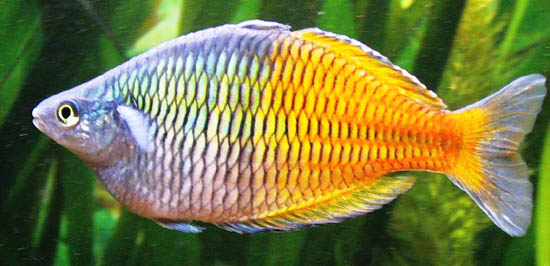
Boeseman's Rainbowfish: Melanotaenia
boesemani
Sexing:
Females display a broad, dark
mid-lateral stripe accompanied by a series of narrow yellow or
reddish-orange longitudinal stripes corresponding with each scale row,
that deepen or lighten according to mood. Mature, older females often
show colouration similar to subordinate males, but females are usually easily
identified by a shallower body/chest depth and smaller, more rounded fin
edges than males. Males are brighter and deeper bodied;
first dorsal fin is longer in males and reaches the second dorsal fin; the
dorsal fins on females do not meet.
Young fish take some time to
grow and show their distinctive colouring but is developed by 4 cms size
(usually).
Reproduction: dioecism, external, spawns
in plant growth.
Tank Community: Peaceful, active in
shoals.
Best kept in shoals of 6 or more.
Frequent partial water changes are vital for care of this species.
Comments:
Once reported that this
species is not suited to being kept in hard water with
pH >7.2 (doubtless in
deference to Boeseman's initial report of low pH values), it has become a popular
pet species in Australia and is kept in a variety of water conditions,
even in Sth Australia's notoriously hard, alkaline, tap water. Water
must be well aged and nitrite free.
Best kept in an established tank that has been running well for many
months.
Keep these fish in shoals of 6+ with plant cover.
|
|
Colour flashes on Boeseman's Rainbowfish
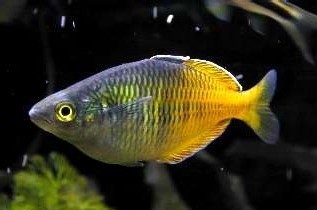 A typical, adult, male M. boesemani is pictured at right. Like
all Rainbowfish, the iridescence on the body of a live fish, flashes
and changes in fractions of a second, as the iridiophores change appearance
with the mood of the fish. In M. boesemani there is a
bright, iridescent, green stripe or blaze running from the mouth, along the
top of the head and back to the second dorsal fin. M. lacustris has a similar, bright, iridescent
blaze that grades in colour from orange-tan to white. The
picture, at right, clearly shows a pale, blue colour along the head
of M. boesemani but does not
capture the iridescence well. When
viewed from above, this stripe is bright and very prominent.
However, it is not
always present. It comes and goes, brightens and flashes, with the
mood of the fish. It varies in colour, too, from iridescent green to
nearly white. I have seen a similar flashing stripe in M.
lacustris, M. maccullochi, and M. splendens but of a different colour-
bright golden-yellow in M.
maccullochi and M.
splendens. It is as though the fish turns on this iridescence in
response to another fish (or me observing above him) as a signal.
The only other animals that I have seen showing such a rapid flash
of iridiophores are other rainbowfish, cichlids, leather-jackets and
the marine Cuttlefish. A typical, adult, male M. boesemani is pictured at right. Like
all Rainbowfish, the iridescence on the body of a live fish, flashes
and changes in fractions of a second, as the iridiophores change appearance
with the mood of the fish. In M. boesemani there is a
bright, iridescent, green stripe or blaze running from the mouth, along the
top of the head and back to the second dorsal fin. M. lacustris has a similar, bright, iridescent
blaze that grades in colour from orange-tan to white. The
picture, at right, clearly shows a pale, blue colour along the head
of M. boesemani but does not
capture the iridescence well. When
viewed from above, this stripe is bright and very prominent.
However, it is not
always present. It comes and goes, brightens and flashes, with the
mood of the fish. It varies in colour, too, from iridescent green to
nearly white. I have seen a similar flashing stripe in M.
lacustris, M. maccullochi, and M. splendens but of a different colour-
bright golden-yellow in M.
maccullochi and M.
splendens. It is as though the fish turns on this iridescence in
response to another fish (or me observing above him) as a signal.
The only other animals that I have seen showing such a rapid flash
of iridiophores are other rainbowfish, cichlids, leather-jackets and
the marine Cuttlefish.
The Australian Museum fish site reports:
"Many species of fishes however can change colour. The changes can
be slow or fast. Slow changes of colour (eg breeding colouration)
are generally under the control of hormones and are usually
semi-permanent.
Rapid colour changes (eg stress responses)
are largely under control of the nervous system although hormones
may also be involved. The colour of fishes can also vary with the
seasons, between day and night and even with changes in habitat and
food.
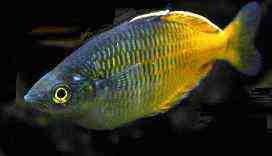 There are two kinds of cells that give
colour to fishes, chromatophores and iridiophores (also called
iridocytes). The Chromatophores are located in the dermis of the
skin, above or below the scales. They
impart true colour (rather than
structural colour)
and contain black, red, yellow, blue, white (and rarely green)
pigment granules called chromatosomes. Only one colour is found in
each chromatophore. Colour changes result from chromatosomes
concentrating in the centre of the chromatophore or dispersing
throughout the cell. There are two kinds of cells that give
colour to fishes, chromatophores and iridiophores (also called
iridocytes). The Chromatophores are located in the dermis of the
skin, above or below the scales. They
impart true colour (rather than
structural colour)
and contain black, red, yellow, blue, white (and rarely green)
pigment granules called chromatosomes. Only one colour is found in
each chromatophore. Colour changes result from chromatosomes
concentrating in the centre of the chromatophore or dispersing
throughout the cell.
Iridiophores contain highly reflective
guanine crystals. The crystals act as mirrors, which reflect the
colours of the outside environment. Iridiophores are responsible for
the silvery appearance of many pelagic fishes." (Source)
The ability to change colour makes Boeseman's Rainbowfish fascinating
to watch, as both the chromatophores and iridiophores constantly
change to give a range of colour changes, depending upon time of day
or whether the
fish is feeding, courting or stimulated in some way. |
|
The Lake
Kutubu Rainbowfish- Melanotaenia
lacustris
(Munro 1964); The Cobalt
Blue Rainbowfish; Turquoise Blue Rainbowfish.
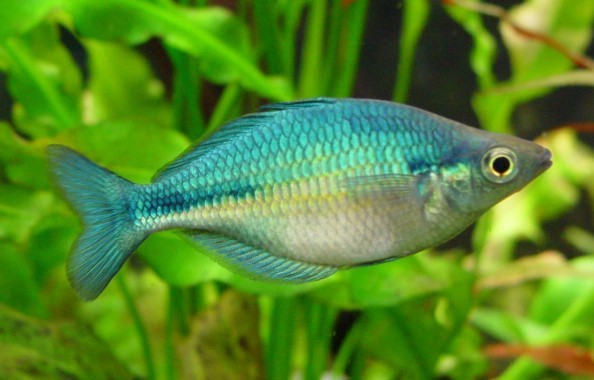
Melanotaenia lacustris, male,
blue/silver |
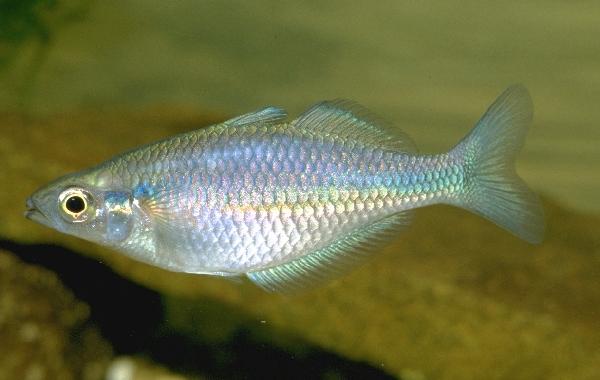
Melaenotaenia lacurtris,
female; compare difference in body
depth |
Description: a medium sized
rainbowfish, with a laterally compressed body and small head; coloured
vivid blue in mature males; iridescent scales; overall silvery-blue body
colour, darker above, pale below, with small, blue-black lateral line
stripe at the tail end; a bright, iridescent stripe outlines the lateral
line; fins blue outline in black. Has a
bright, golden-tan to blue-white, iridescent line along the back, from mouth to
dorsal fin, which is more or less present, depending on the mood of the
fish. This blaze is tan to orange coloured at the head and grades to near
white at the dorsal fin. The blaze along the upper edge of the body
flashes colour with the mood of the fish. Depending on water conditions, captive environment and diet,
Melanotaenia lacustris can display an array of different colours and
patterns ranging from cobalt blue, steel blue, aquamarine through to
lighter and darker shades of turquoise. When spawning the nape area
changes to a bright orange or golden-tan colouration. Rows of orange-red
dots between the rows of scales are present but not prominent.
Distribution: Southern Highlands of Papua New
Guinea; found only in Lake Kutubu and the Soro River, which is the
only outlet stream of the lake. The Soro River eventually flows into
the Kikori River system. Lake Kutubu is a scenically beautiful
crystal clear lake situated about 40 kilometres from Mendi, the main
town of the Southern Highlands Province in central Papua New Guinea.
Natural Habitat: lake, freshwater
tropical; temperature of water 21-25oC; benthopelagic; freshwater; pH range: 7.0 – 8.6; dH range: 9 - 19.
Conservation Status: Not in
IUCN Red List.
Economic use: Commercial aquarium trade.
Threats: Regarded as vulnerable
in its endemic range; threatened by pollution from the Ok Tedi mining
project which leaches heavy metals into the lake; also at risk by
encroaching settlement.
Size: Approx. 10-12 cms; 7 cm SL
(female); can grow to 11 - 13 cms TL but usually less than 10 cm; males larger than females.
Water Requirements: clear, fresh water, temperature range of 21 to
25°C and a pH of 8.5-9.0.
Tank Habitat: Planted tank with open
swimming spaces. Good filtration required and temperature 25oC pH
7.2 - 8.0.
Diet: Small crustaceans and insect larvae such as mosquito and
midge larvae; opportunistic feeders among plants and in open water; will eat
frozen foods such as blood worms and brine shrimp; adaptable to flakes and
granules.
Sexing: Males are larger than females and have a deeper body and
are more brightly coloured, with a body depth (dorsal to ventral) of 4-5 cm,
much deeper bodied than females.
Reproduction: dioecism, external, spawns
in plant growth. Spawning females produce between 100 and 200 eggs,
spawning a number of times daily for several days. Eggs adhere to water plants
and hatching occurs after 6-10 days, depending on temperature.
Tank Community: Peaceful, active in shoals.
 Comments:
Best kept in shoals of 6 or more fish. They will shoal with
other rainbows of a similar size. The fish shows a variety of colouration at
different times of the day and can change colour rapidly, from blue, greenish
and golden hues to shades of silver, cobalt blue and turquoise. Their
black colour intensifies at night. Comments:
Best kept in shoals of 6 or more fish. They will shoal with
other rainbows of a similar size. The fish shows a variety of colouration at
different times of the day and can change colour rapidly, from blue, greenish
and golden hues to shades of silver, cobalt blue and turquoise. Their
black colour intensifies at night.
Young fish and males display a bright, iridescent, white to golden-tan to white stripe along the head
and back, which they flash when excited or displaying. The pictures at
left and below, right, show the colour blaze, which is prominent at breeding and during displays
by the fish. This flashing colour blaze is also shown in other species of
rainbowfish to a greater of lesser degree.
The Lake Kutubu Rainbowfish is something of a chameleon, with individuals
changing colour rapidly, depending on water conditions, time of day and mood.
The flashes of colour along the top of the body, from head to dorsal fin, as
shown at left, is especially remarkable in this species. The colour blaze on the
forehead varies from orange-tan to white and brilliant, colour flashes, in
shades of yellow, green, blue, purple and violet, flicker on and off in
fractions of a second. This behaviour is particularly noticeable in breeding
males. See my article on "Colour Changes in Rainbowfish"
for more comments.
This is an active species and swims in the middle ranges of the aquarium against
any small current that is present. They are active jumpers and leap at food on
the surface so that cover is essential. They are an easy species to keep, in my
experience, and do not require high water temperatures.
|
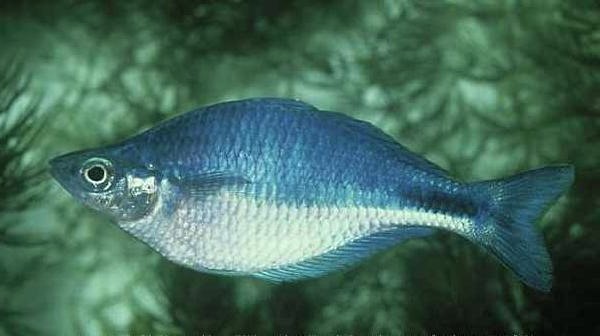
M. lacustris, male cobalt blue |
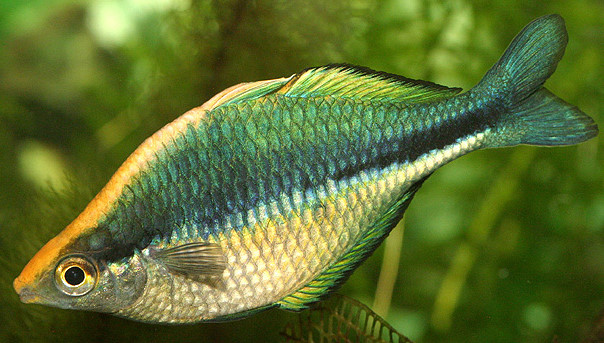
M. lacustris, male, turquoise, gold
and black, showing blaze on head |
|
| Parkinson’s Rainbowfish- Melanotaenia
parkinsoni
(Allen & Cross 1980) .
Description: a relatively slender, medium sized rainbowfish, with
a laterally
compressed body and small head; vivid colour in mature males;
iridescent
scales; overall silvery body colour with a rosy "chest" and narrow orange stripes
between the scale rows. The fins of adult males are bright orange (or
yellow) with dark edges. The posterior half of the adult male body has
patchy, orange or yellow
bars.
Sometimes the bars or blotches fuse to cover the entire posterior half of the body. Colour development is slow.
Selected "forms" include deeper yellow and orange coloured fish.
Distribution: Southern Papua New Guinea; found along the
southern coast of eastern Papua New Guinea between the Kemp River and
Milne Bay.
Natural Habitat: Riverine, freshwater
tropical, 27-30°C; benthopelagic; freshwater; pH range: 7.06 – 8.0; dH range: 9 - 19.
Found in streams in a grassy plains habitat with patchy rainforest
immediately adjacent to the creeks. The waters are subject to seasonal low water
during the dry season.
Conservation Status: Not in
IUCN Red List.
Economic use: Commercial aquarium trade.
Threats: Unknown.
Size: Approx. 11.0 cm SL
(male/unsexed; 9.0 cm SL (female); not as deep bodies as some rainbowfish.
Water Requirements: tropical, freshwater tropical, 27-30°C; pH 7.6
- 7.8; alkaline water.
Tank Habitat: Planted tank with open
swimming spaces. Good filtration required and temperature 25oC- 27oC, pH 7.4
- 7.6.
Diet: Small crustaceans and insect larvae;
will eat flake foods, blood worms and daphnia; adaptable to flakes and
granules. Some vegetable matter in the diet in necessary and Spirulina Flakes
and/or skinned green peas do well for this.
Sexing: Females dull; males develop brighter yellow colouration
and pinkish "chest". Some males show longer dorsal fins with
thread-like tips. Reproduction: dioecism, external, spawns
in plant growth. Spawning females producing between 20-50 eggs each day for
several days. Eggs adhere to fine-leaved plants or among the roots of
floating vegetation. Hatching occurs in about 8 to 10 days at
temperatures between 24-28°C.
Tank Community: Females are peaceful, active in shoals; males
reputedly more aggressive than other Melanotaenia sp. and can be
territorial to other male rainbowfish, resulting in threat displays. Fish are seldom injured in
confrontations. Best kept in large, well
planted tanks, at about 27°C in shoals of 6 or more. Needs swimming space and
cover.
|
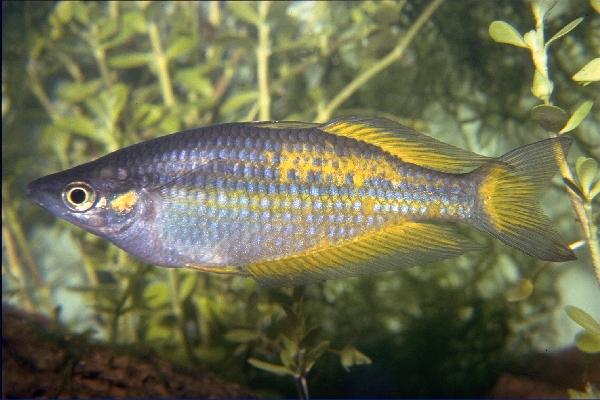
Melanotaenia parkinsoni (male) with more typical colouring.
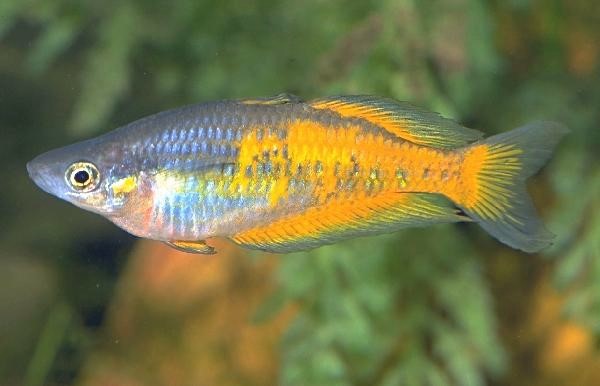
Melanotaenia parkinsoni (male) showing more colour than usual.
Comments:
Young fish take some time to
grow and show their distinctive colouring.
Select a shoal of fish about the same size; does well with other Rainbows from
New Guinea and will shoal with them.
|
Macculloch's
Rainbowfish -
Melanotaenia maccullochi (Ogilby,
1915)
Description: A small rainbowfish, with
laterally compressed body. Several geographically isolated populations
are found in New Guinea, Northern Territory, northern Queensland. The dorsal and anal fins are orange-red with a lower
black margin running along the body line. The dorsal edge of the fish
has a bright, iridescent stripe. The caudal fin has a fan of
orange-red colouration. Females are much less colourful, though some do
show a hint of the male's coloration. Females tend to grow larger and
have deeper bodies than males.
Species Diagnosis:
Dorsal
spines
(total): 5-8; Dorsal soft-rays (total): 7-12; Anal spines: 1-1; Anal
soft-rays:
13-19.
Distribution: Australasia;
Papua
New Guinea
(lower and middle sections of the Fly River westward to the Bensbach
River)
and north-eastern Australia. Natural Habitat: benthopelagic;
freshwater;
pH range: 7.0; dGH range: 10.0; Climate: tropical; 20 - 25°C. Inhabits lowland swamps and small streams, usually in clear, acidic
waters
with ample cover in the form of log debris or aquatic vegetation.
Conservation Status: Not in
IUCN Red List.
Threats: Habitat degradation.
Size: Max. size: 6.0 cm SL
Water Requirements: tropical
freshwater
20 - 25°C.; pH range: 7.0; dGH range: 10.0;
Tank Habitat: dense planting, with open
swimming places and
logs to provide cover. Neutral water around 24°C and good water quality.
Diet: Omnivorous. Adapts to flakes and
responds to occasional feedings of live foods.
Sexing: Males have
a deeper body profile and longer fins.
Reproduction: dioecism, external,
non-guarders.
|
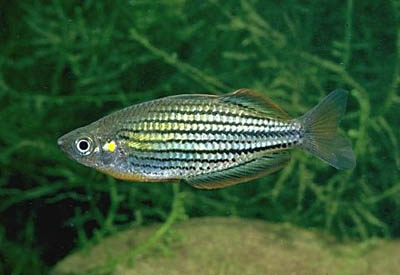
M. maccullochi Photo Neil Armstrong
Tank Community:
Makes a good community fish with other rainbows and gudgeons requiring
similar water conditions.
Incompatible Species:
Rainbowfish that prefer alkaline water; larger fishes; Arowanas (Yes, mine
swallowed them in one gulp when he grew big enough and decided that his tank
mates were food).
Comments: Specimens from New Guinea
show deeper colours than the Australian form. Can be kept with other small
rainbowfish such as M. praecox. I have not kept the Papua New Guinea
species. The Australian form from Harvey Creek seems adaptable to water conditions from soft to
moderately hard, pH adjusted to 70. - 7.4. |
| Dwarf Neon
Rainbowfish
- Melanotaenia praecox (Weber & Beaufort 1922) syn.
Rhombatractus
praecox, Nematocentris praecox. Description: Slender, laterally
compressed
fish, with marked narrowing at the beginning of the caudal fin; bright
iridescent colour with "neon" blue line along the back. Male
brighter,
with dorsal and anal fins edged in red.
Distribution: Endemic to New
Guinea and Irian Jaya (Mamberano River).
Natural Habitat: Riverine, with bushy
plant
cover.
Conservation Status: Unknown.
Threats: Unknown.
Size: Approx. 6.0 cms. One of the small
Rainbowfish.
Water Requirements: Flowing,
clean
freshwater; Soft and slightly acidic (pH 6.8 - 7.0); adaptable
to near neutral
water. Temperature 25- 27oC. Good filtration
required.
Tank Habitat: Well planted tank
with open
swimming spaces.
Diet: Small crustaceans &
insect
larvae;
will eat flake foods, blood worms and daphnia
Sexing: Males bright,
iridescent
blue, with red edges to fins, slight humped back; females paler blue
with
yellow fins. Both sexes show little colour until 2-3 cms in size.
Reproduction: Readily spawns in
plant
growth. Parents ignore the fry and do not eat them.
|
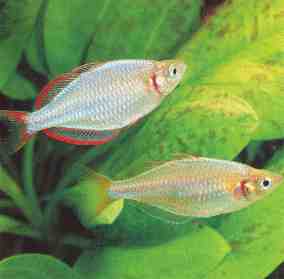
Dwarf Neon Rainbowfish
Tank Community: Generally peaceful, shy but
active in shoals; keep with small fish or in species tank. Some males chase
other fish away from desired females.
Comments: Easily scared into a
"comatose" fit! Keep these fish in shoals of 6+ with plant cover. This
species has a reputation for being delicate and subject to bacterial infections. Tank
bred specimens may be hardier. May be kept with other dwarf rainbows, Cardinal Tetras and Red-line Rasboras to good effect, in a
well planted aquarium. |
|
Red-striped Rainbow Fish - Melanotaenia splendida rubrostriata (Ramsay & Ogilby, 1886); Ruby Rainbowfish. Description:
laterally compressed, deep set rainbowfish with a small head; upper body has
iridescent, bluish scales and five, longitudinal orange/red to salmon pink
stripes running from behind the head to the tail and reaching to the
mid-line of the body below which is another four or five less prominent or
broken stripes extending across the pale belly; fins red edged in black
with bright blue spots and dashes between the red rays; variable rainbow
colours in males c.f females; colour between stripes varies with mood-
silver grey in calm mood, silvery sky-blue to violet in excited specimens.
Distribution: South of the dividing
range in New Guinea and Irian Jaya, from between the Aramia River (near
the Fly River) of Papua New Guinea and Etna Bay in central Irian Jaya,
Indonesia and also the Aru Islands in the Arafura Sea and Daru Island near
Torres Strait.
Natural Habitat: Riverine, coastal lowlands and swamps around
submerged branches and vegetated swamps. Waters are soft, with
pH range: 5.6 – 7.4. Temp. 25-30oC.
Conservation
Status: Unknown.
Threats: Unknown.
Size: Approx. 6.0 to 12 cms.
Water Requirements: Freshwater; Soft and slightly
acidic (6.8 - 7.0); adaptable to near neutral water. Temperature 25-
27oC. Good filtration required.
Tank Habitat: Planted tank with open
swimming spaces; some natural light.
Diet: Small crustaceans and
insect larvae, vegetable matter- algae and Duck Weed; will eat flake
foods, blood worms and daphnia; adaptable to flakes and granules.
Sexing: Males brighter and deeper bodied;
first dorsal fin longer in males and reaches the second dorsal fin- in
females it does not.
|

Melanotaenia splendida rubrostriata
Reproduction: Spawn in plant growth.
Spawning usually occurs from October to December, with females producing
between 100 and 200 eggs, spawning a number of times daily for several
days. Eggs adhere to fine-leaved plants or among the roots of floating
vegetation with hatching occurring after 6-7 days.
Tank Community: Generally peaceful, active in shoals.
Keep in shoals of 6 or more.
Comments: Keep these fish with plant
cover. As this fish is a shoaling species, it is best kept in groups of 6
or more.
|
Link to Notes on
Keeping Australasian Blue-eyes- also related to the the Rainbows.
Link to Notes on Keeping
Australian Rainbowfish
Link to Notes on Fishkeeping
Breeding Rainbows
Return to
Previous Page
INDEX
  
THANKYOU FOR
VISITING ANOTHER WATERSHED AQUACULTURE EDUCATIONAL SITE
GOOD LUCK WITH YOUR RAINBOWS

Disclaimer |



 A typical, adult, male M. boesemani is pictured at right. Like
all Rainbowfish, the iridescence on the body of a live fish, flashes
and changes in fractions of a second, as the iridiophores change appearance
with the mood of the fish. In M. boesemani there is a
bright, iridescent, green stripe or blaze running from the mouth, along the
top of the head and back to the second dorsal fin. M. lacustris has a similar, bright, iridescent
blaze that grades in colour from orange-tan to white. The
picture, at right, clearly shows a pale, blue colour along the head
of M. boesemani but does not
capture the iridescence well. When
viewed from above, this stripe is bright and very prominent.
However, it is not
always present. It comes and goes, brightens and flashes, with the
mood of the fish. It varies in colour, too, from iridescent green to
nearly white. I have seen a similar flashing stripe in M.
lacustris, M. maccullochi, and M. splendens but of a different colour-
bright golden-yellow in M.
maccullochi and M.
splendens. It is as though the fish turns on this iridescence in
response to another fish (or me observing above him) as a signal.
The only other animals that I have seen showing such a rapid flash
of iridiophores are other rainbowfish, cichlids, leather-jackets and
the marine Cuttlefish.
A typical, adult, male M. boesemani is pictured at right. Like
all Rainbowfish, the iridescence on the body of a live fish, flashes
and changes in fractions of a second, as the iridiophores change appearance
with the mood of the fish. In M. boesemani there is a
bright, iridescent, green stripe or blaze running from the mouth, along the
top of the head and back to the second dorsal fin. M. lacustris has a similar, bright, iridescent
blaze that grades in colour from orange-tan to white. The
picture, at right, clearly shows a pale, blue colour along the head
of M. boesemani but does not
capture the iridescence well. When
viewed from above, this stripe is bright and very prominent.
However, it is not
always present. It comes and goes, brightens and flashes, with the
mood of the fish. It varies in colour, too, from iridescent green to
nearly white. I have seen a similar flashing stripe in M.
lacustris, M. maccullochi, and M. splendens but of a different colour-
bright golden-yellow in M.
maccullochi and M.
splendens. It is as though the fish turns on this iridescence in
response to another fish (or me observing above him) as a signal.
The only other animals that I have seen showing such a rapid flash
of iridiophores are other rainbowfish, cichlids, leather-jackets and
the marine Cuttlefish.

 Comments:
Best kept in shoals of 6 or more fish. They will shoal with
other rainbows of a similar size. The fish shows a variety of colouration at
different times of the day and can change colour rapidly, from blue, greenish
and golden hues to shades of silver, cobalt blue and turquoise. Their
black colour intensifies at night.
Comments:
Best kept in shoals of 6 or more fish. They will shoal with
other rainbows of a similar size. The fish shows a variety of colouration at
different times of the day and can change colour rapidly, from blue, greenish
and golden hues to shades of silver, cobalt blue and turquoise. Their
black colour intensifies at night.



